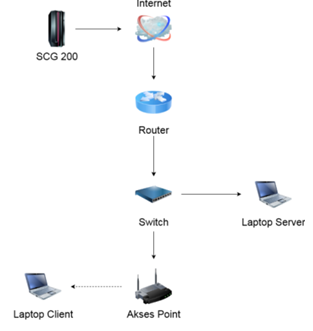Analisa Kinerja Penerapan Standard Protokol Keamanan IEEE 802.11 Pada Layanan Wireless Fidelity
Abstract
Communication network depends on the WLAN , and there is so much demand on the Quality Of Service (QoS) WLAN like Throughput , delay , and filter to secure the Communication Data , therefore a network security mechanism is using the Wired Equivalent Privacy (WEP), WiFi Protected Access (WPA), and WPA2 [14]. Mall Bali Galleria has several alternative for free WiFi, There is so many Wi-Fi has been installed causing the problem interference, and that affect the performance of the WiFi, MBG has the Indoor and Outdoor Area, The alternative to handle the interference is to using the automation channel by implementing Channel Fly , Background Scanning and Static Channel. From the security mechanism, Channel And Frequencies made by doing scenario on every single access point to get the best scenario , from the scenario that has been submitted The best score of the packet loss on indoor area Scenario that uses 4 AP with the 5Ghz Frequency , static channel , WEP-64 is 0,016ms of the packet loss , the Outdoor areas scenario that uses 5 AP with 5Ghz frequency ,Channel Fly , WEP-64 get 0,094ms of the packet loss , The best jitter score for the indoor area that uses 2 AP , 5Ghz Background Scanning , WPA 2 is 1.336ms of the jitter, outdoor area 8 AP , 5Ghz Frequency , static channel , WPA2-Mixed get 1,116 ms of Jitter , The Throughput best scores is indoor area with 1 AP , 5Ghz Frequency, Static Channel , WPA2-Mixed get 78,7Mbps of the Throughput, for the Outdoor Areas using 8 AP , 5Ghz Frequency , Background Scanning, Disable Security is 80Mbps Of The Throughput , if it compared with the existing scenario the performance is improved to 10-30%. WEP has good packet loss score however it has smallest Throughput. Static channels are recommended on the location that have high interference.
Downloads
References
[2] B. A. Nugroho, H. Supriyono and J. Wantoro, “Analisis Keamanan Jaringan pada Fasilitas Internet (WiFi) Terhadap Serangan Packet Snifing,” 2012.
[3] E. Barka, M. Boulmalf, A. A. H. A. Suwaidi, H. Khazaimy, and M. A. Mansouri, “Impact of Security on the Performance of Wireless-Local Area Networks,” 2006
[4] Handdy I. G. M, Diafari I. G. A. K, and Indra N, “Pemanfaatan Media Sosial Sebagai Otentifikasi dan Otorisasi Akses ke Jaringan WiFi” E-Jurnal SPEKTRUM Vol. 3, No.2 Desember 2016. 2016.
[5] I. M. O. Widyantara, B. D. Cahyono and W. Setiawan, “Analisa Horizontal Handover Terhadap QoS Layanan Streaming Multimedia E-Learning Pada Jaringan WLAN 802.11,” Jurnal Teknologi Elektro., Vol.14, No.1, 2015.
[6] K. C. Hu, S. W. Wang, M. C. Chiang, and C. W. Tsai, “An efficient hybrid algorithm for balancing the load of wireless local area network,” Computers and Electrical Engineering (2016). http://dx.doi.org/10.1016/j.compeleceng.2016.09.036. 2016.
[7] K. Y. Krisnawan, N. P. Sastra, and N. M. A. E. D. Wirastuti, “Optimasi Nirkabel Local Area Networks Fakultas Teknik Kampus Sudirman Universitas Udayana,” E-Journal SPEKTRUM Vol. 5, No 1 Juni 2018. 2018.
[8] Linawati, N. Gunantara and I. K. A. R. Gunawan, “Performansi WLAN Kantor Pusat Pemerintahan Kabupaten Badung,” Teknologi Elektro., Vol.14, No.2, 2015.
[9] N. M. A. E. D. Wirastuti and C. C. W. Emehel, “Handover Scenarios for Mobile WiMAX and Wireless LAN Heterogeneous Network,”. Telkomnika Indonesian Journal Electrical Engineering, Vol. 12, No. 8,. 2014.
[10] O. Bejarno, and E. W. Knightly, “IEEE 802.11ac: From Channelization toMulti-User MIMO,” Rice UniversityMinyoung Park, Intel Corporation. 2013.
[11] P. D. Pradnyana, D. M. Wiharta, and N. P. Sastra, “Analisis Cakupan Layanan Wi-Fi Gedung Pascasarjana Universitas Udayana,” Jurnal SPEKTRUM Vol. 6, No. 2 Juni 2019. 2019.
[12] R. Murty, J. Padhye, R. Chandra, A. Wolman, and B. Zill, “Designing High Performance Enterprise Wi-Fi Networks,”. Harvard University, Microsoft Research. 2008.
[13] S. Jeon, Y. S. Shim, and S.Park, “Study of the Throughput of WLAN According to Channeling and Density of AP,” 19th International Conference on Microwaves, Radar & Wireless Communications. 2012
[14] S. Lepaja, A. Maraj, A. Efendiu, and S. Berzati, “The Impact of the Security Mechanisms in the Throughput of the WLAN Networks,” 7th Mediterranean Conference on Embedded Computing. 2018.
[15] S. Zaim, “Apakah WPA/WPA2 Benar-Benar Aman? Deskripsi Paket Data Terenkripsi Pada WPA/WPA2,” Seminar Nasional Informatika, 2015 (semnasIF 2015), 2015.
[16] T. A. T. Aziz, M. R. A. Razak, and N. E. A. Ghani, “The Performance of Different IEEE802.11 Security Protocol Standard on 2.4GHz and 5GHz WLAN Networks,” International Conference on Engineering Technology and Technopreneurship (ICE2T). 2017.
[17] U. Singh and P. Jindal, “Performance Analysis of Secure Wireless Local Area Network using Test-bed,” 2014 Fourth International Conference on Advanced Computing & Communication Technologies. 2014.
[18] “Data Sheet Ruckus ZoneFlex T301.” [Online]. Available: https://www.ruckussecurity.com/ZoneFlex-T301.asp. [Accesed: 10-December-2020].
[19] “Data Sheet Ruckus ZoneFlex R700.” [Online]. Available: https://www.ruckussecurity.com/ZoneFlex-R700.asp. [Accesed: 10-December-2020].
[20] “Background Scanning and Channel Fly.” [Online]. Available: https://docs.ruckuswireless.com/unleashed/200.1.9.12/c-SelfHealing.html. [Accesed: 10-December-2020].
[21] Telecommunications and internet Protocol Harmoniza Over Networks (TiPHON), General aspect of Quality of Service (QOS), Tiphon 1999.


This work is licensed under a Creative Commons Attribution-NonCommercial-NoDerivatives 4.0 International License.

This work is licensed under a Creative Commons Attribution 4.0 International License




